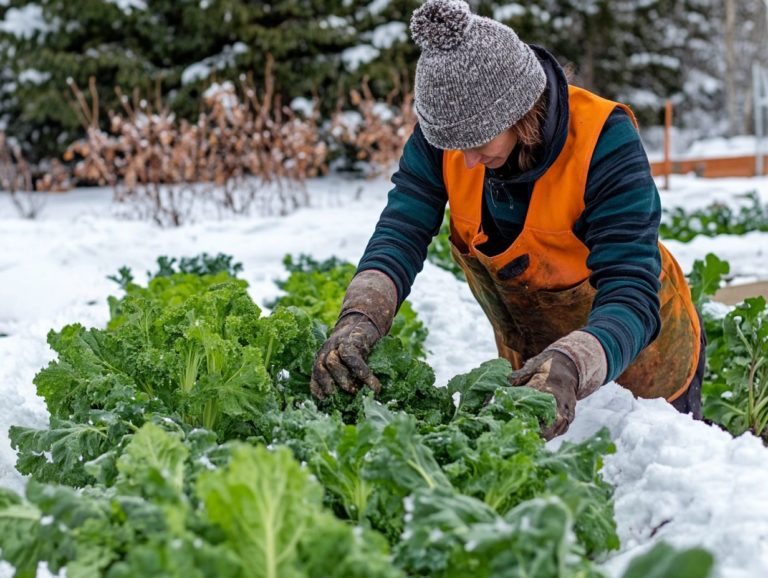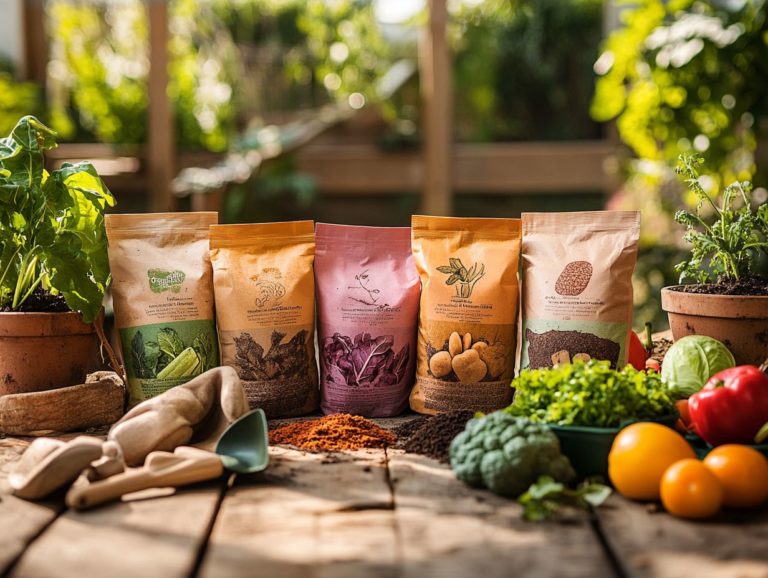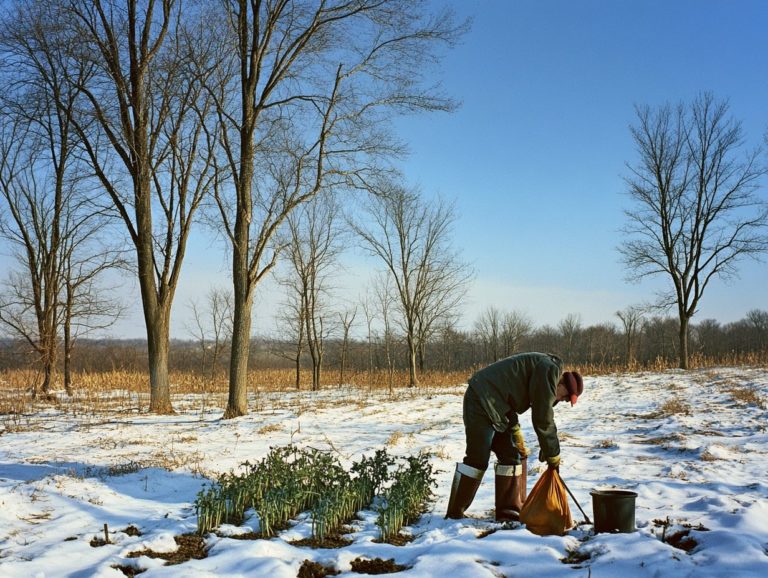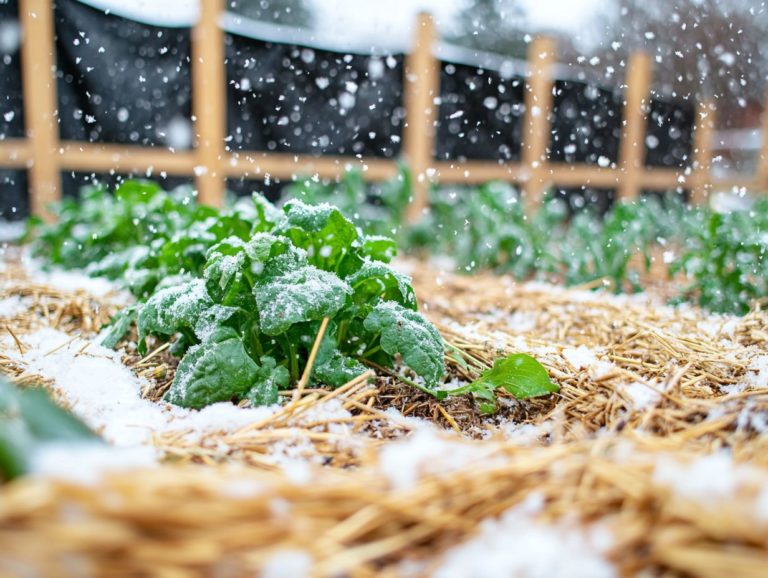Winter Crop Care: Signs of Stress to Watch For
Are your winter crops struggling? Discover how to help them thrive against all odds! Winter crops encounter distinct challenges that can lead to stress, ultimately affecting their health and yield. Recognizing the root causes of this stress is crucial for both farmers and gardeners.
This article delves into the signs of stress you should watch for, covering everything from physical indicators to visual symptoms.
It also provides effective strategies for preventing and managing stress. You’ll learn how to evaluate crop health and tackle common winter pests and diseases. Equip yourself with the knowledge necessary to ensure your winter crops not only survive but thrive!
Contents
- Key Takeaways:
- Understanding Winter Crop Stress
- Signs of Stress in Winter Crops
- Preventing and Managing Winter Crop Stress
- Assessing Crop Health During Winter
- Dealing with Winter Pests and Diseases
- Frequently Asked Questions
- What is winter crop care and why is it important?
- What are some common signs of stress to watch for in winter crops?
- How can I prevent stress in my winter crops?
- What should I do if I notice signs of stress in my winter crops?
- Are there specific pests or diseases that can cause stress in winter crops?
- How can I prepare my winter crops for the transition to spring?
Key Takeaways:
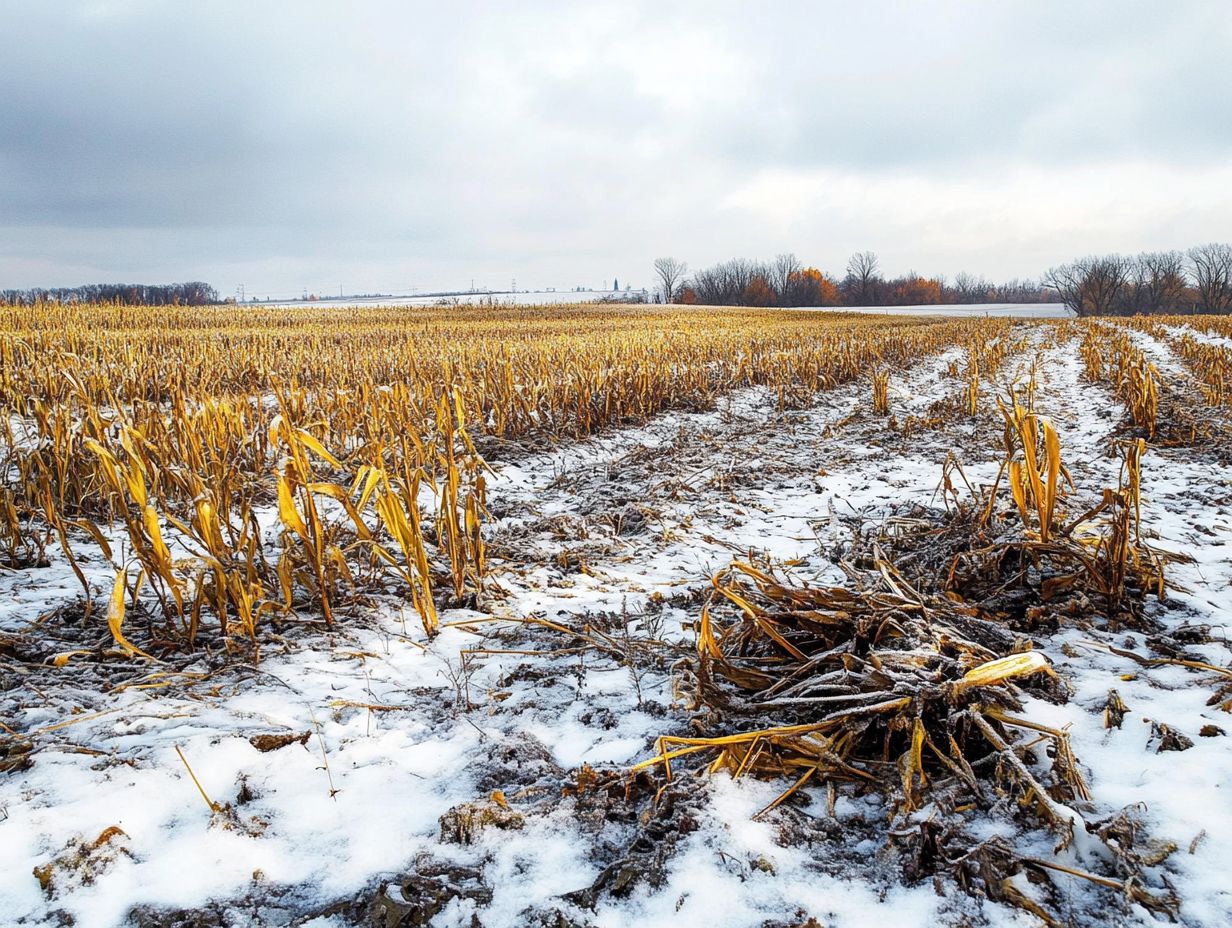
- Monitor physical and visual indicators such as wilting, discoloration, and stunted growth to identify signs of stress in winter crops.
- Prevent and manage winter crop stress through effective strategies like mulching, irrigation, and crop rotation.
- Regularly assess crop health during winter by closely monitoring growth and making necessary adjustments to ensure optimal growth and yield.
Understanding Winter Crop Stress
Grasping the intricacies of winter crop stress is essential for you as a farmer or agricultural consultant. It helps you effectively alleviate the adverse impacts of environmental challenges, including heat stress, cold stress, and drought stress.
These stressors can significantly impact your crop yields and quality. This can result in problems such as wilting, nutrient deficiencies, and blossom-end rot in crops like tomatoes, corn, and cucumbers.
By implementing diligent crop monitoring and managing soil moisture levels, you can navigate temperature extremes. This allows your plants to flourish, even during harsh winter conditions.
What Causes Stress in Winter Crops?
Various factors contribute to stress in your winter crops. Heat stress, cold stress, and drought stress can lead to significant yield reductions.
Extreme temperatures create an unforgiving environment for these plants. They become vulnerable to frost damage or excessive heat, disrupting their natural growth processes.
Inadequate soil moisture exacerbates these challenges, limiting nutrient uptake and hindering root development. When nutrient deficiencies arise especially with essential elements like nitrogen or potassium your crops may struggle to withstand these stresses.
This deficiency not only stunts growth but also increases the likelihood of diseases, ultimately compromising overall crop health and productivity. Effectively managing these conditions is critical for you as a farmer, especially if you aim to achieve robust winter harvests.
Signs of Stress in Winter Crops
Recognizing the signs of stress in winter crops is crucial for effective crop management. After harvest, it’s important to follow guidelines for winter crop care. Look for symptoms like wilting, nutrient deficiencies, and alterations in leaf margins, as these can indicate that photosynthesis is suffering.
By sharpening your observational skills, you can take proactive measures to ensure your crops thrive through the winter months.
Physical and Visual Indicators
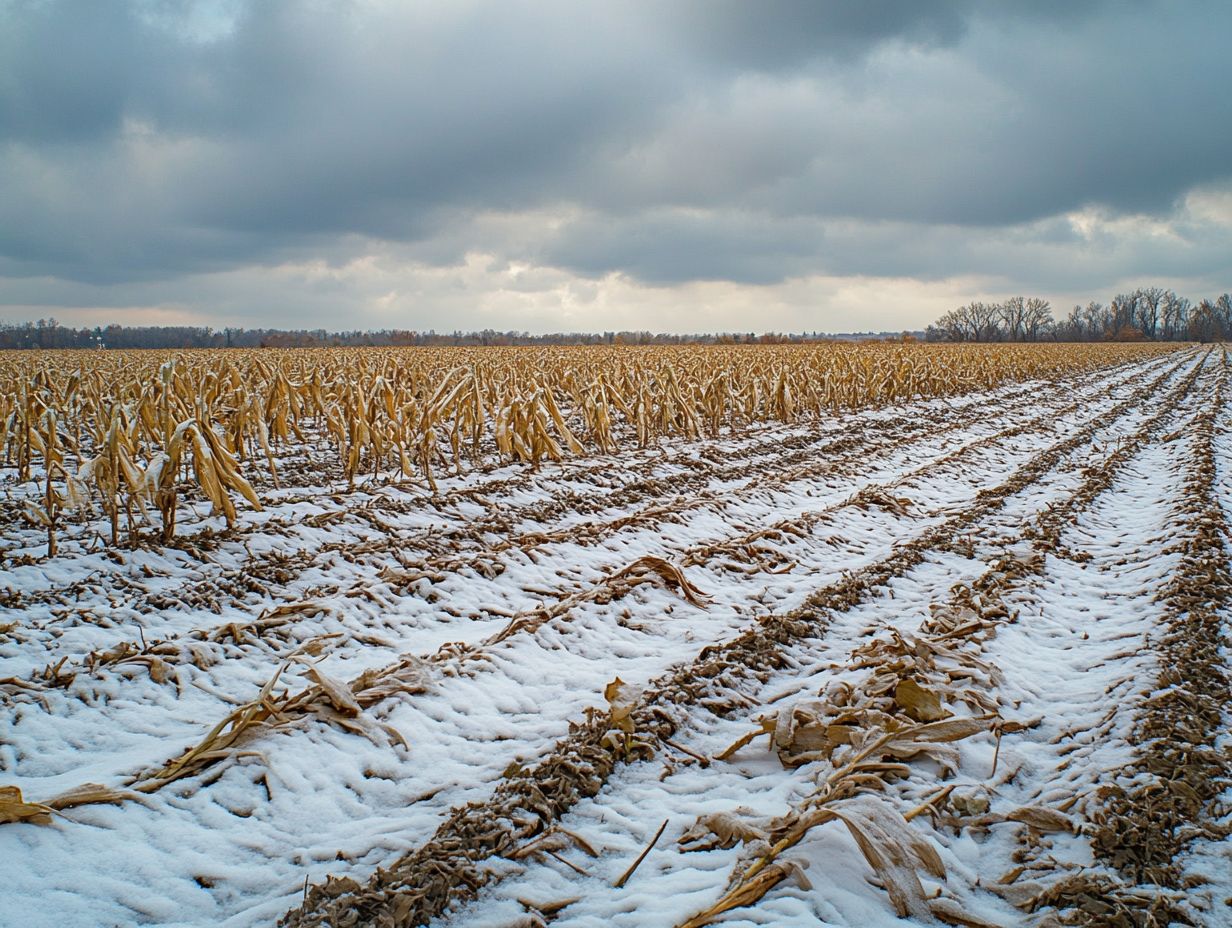
You may notice physical and visual indicators of winter crop stress manifesting as wilting and changes in leaf margins. Signs of nutrient deficiency can also significantly impede photosynthesis.
These indicators can appear in various ways, such as discolored patches on leaves, hinting at pest infestations or diseases. Stay vigilant for curling leaves or unusual growth patterns, as these may signify underlying stressors.
To monitor these signs effectively, use technologies like drone surveillance or soil moisture sensors. Catching symptoms early allows you to implement targeted strategies whether adjustments in irrigation, tweaks in fertilization, or protective measures against pests ultimately enhancing the health and productivity of your crops.
Start monitoring your crops today for a healthier winter harvest!
Preventing and Managing Winter Crop Stress
Preventing and managing winter crop stress requires a strategic approach. Implement effective irrigation practices and consider using shading crops to adapt to changing conditions.
Leverage advancements in genetic enhancement to help your plants handle water stress. By doing so, you ll ensure your crops thrive even in challenging conditions.
Effective Strategies and Techniques
Manage winter crop stress by using proper irrigation techniques and maintaining optimal soil moisture levels. These methods are essential for helping your crops withstand fluctuating winter temperatures.
For instance, timed irrigation can significantly improve water efficiency. It allows you to provide moisture exactly when your crops need it, minimizing water stress.
Selecting appropriate shading crops limits direct sunlight exposure. This helps improve soil moisture retention and creates a stable climate for your primary crops.
Employ methods to assess soil moisture, like moisture sensors or manual sampling. These tools give you the data necessary to make informed irrigation decisions.
Together, these strategies form a framework for reducing crop stress during winter.
Assessing Crop Health During Winter
Assessing crop health during winter is essential for guaranteeing optimal growth. Regularly monitor soil moisture levels and nutrient status to keep your plants vigorous.
Consult agricultural experts for guidance on maintaining robust crops ready for the upcoming season.
Monitoring and Adjusting for Optimal Growth
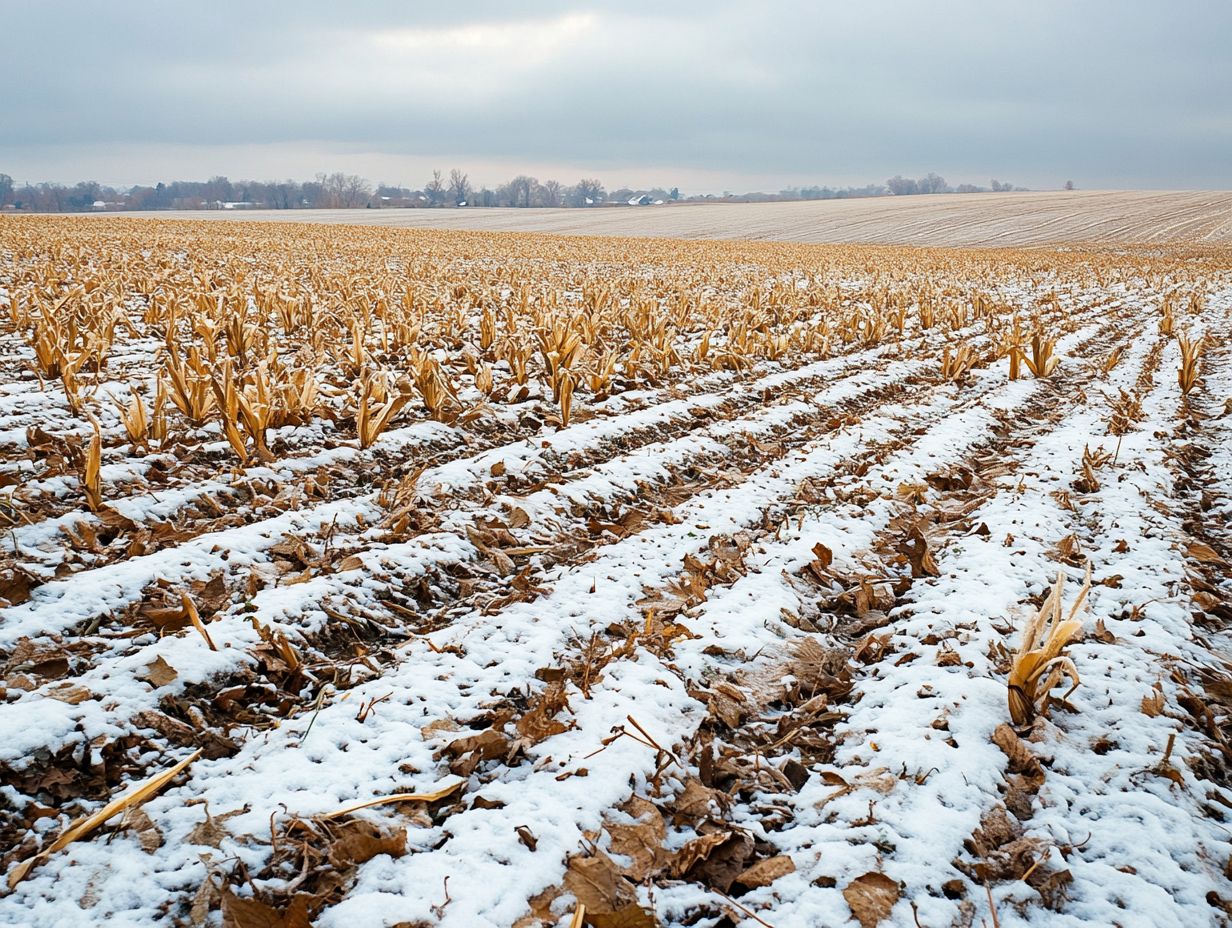
Focus on soil moisture and nutrient levels while monitoring winter crops. Agricultural consultants can provide valuable support in these areas.
These professionals use advanced methods to track crop conditions precisely. For example, soil moisture sensors deliver real-time data, helping you understand when irrigation is needed.
Visual inspections are also essential for assessing crop health firsthand. This combination of data and observations allows you to adjust fertilization and irrigation based on specific needs.
By crafting a dynamic plan for maintaining ideal conditions, you ll achieve higher yields and healthier plants.
Dealing with Winter Pests and Diseases
Addressing winter pests and diseases is vital for preserving the health of your winter crops. Use combined pest control methods to tackle the unique challenges of winter.
Proactive management ensures your crops thrive even in harsh conditions.
Common Winter Crop Pests and Diseases
Pests like aphids and diseases such as fungal infections present significant threats to your crops. Their presence increases stress factors, making plants vulnerable.
Aphids feed on sap, causing stunted growth and potential virus transmission. Fungal infections, like blight or mildew, reduce photosynthesis and plant vigor.
Root rot, often caused by overly damp soil, weakens root systems and hampers nutrient absorption. Regularly inspect your crops to catch these threats early.
Timely interventions protect your crops’ vitality and productivity.
Preventive Measures and Treatment Options
Implementing preventive measures and exploring treatment options is crucial for fighting winter pests and diseases. This ensures your winter crops thrive sustainably.
Adopting practices like crop rotation helps disrupt the life cycles of harmful pests, making it harder for them to establish themselves in your soil. Selecting resistant crop varieties adds an extra layer of protection, leading to a more robust harvest.
When prevention alone isn t enough, using organic pesticides offers an effective treatment option that minimizes harm to the ecosystem. Embracing methods to control pests not only helps monitor populations but also employs various strategies to safeguard your winter crops from unwelcome threats.
Frequently Asked Questions
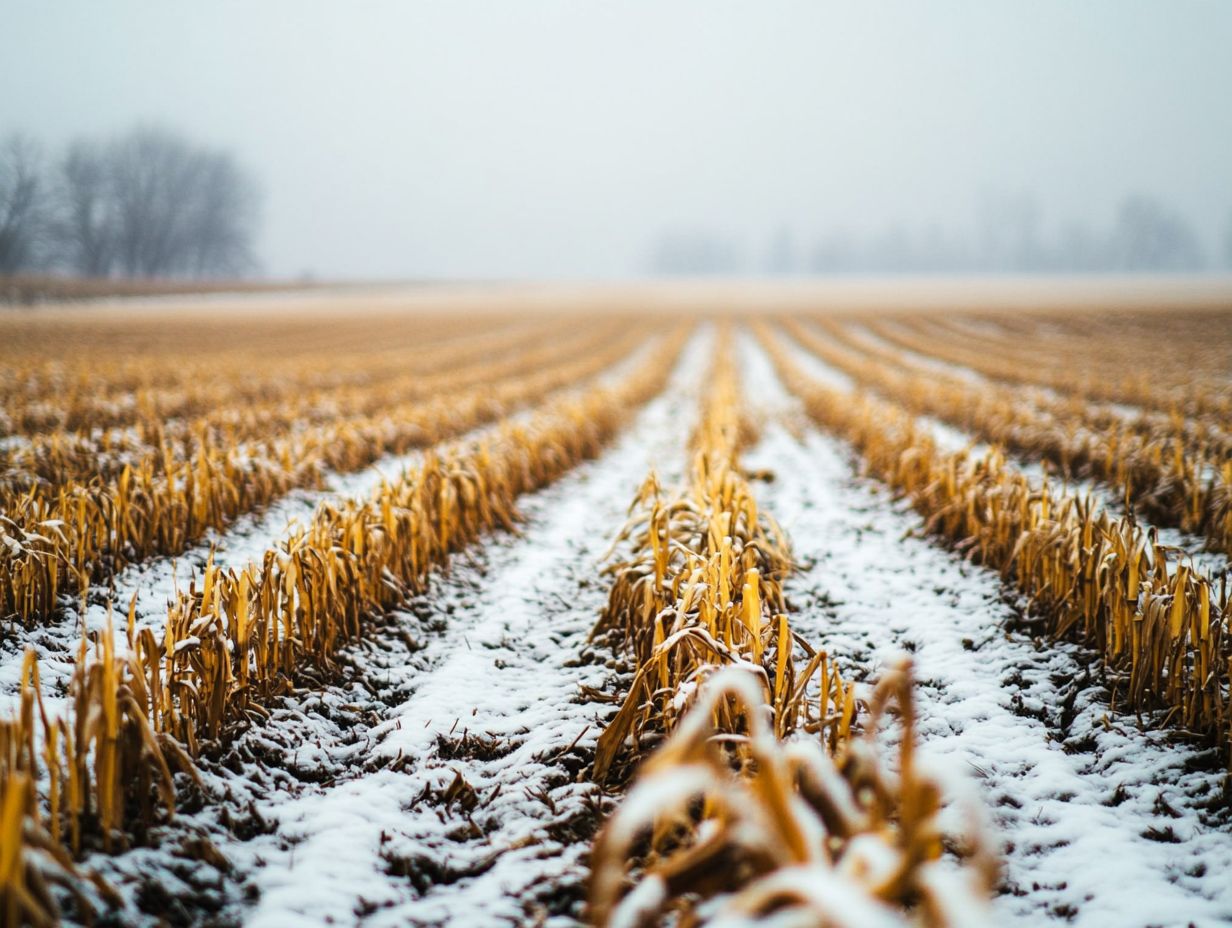
What is winter crop care and why is it important?
Winter crop care refers to the steps taken to protect crops during the winter season. It is essential because extreme cold, snow, and frost can stress and damage crops, leading to decreased yield and quality.
What are some common signs of stress to watch for in winter crops?
Common signs of stress include wilting leaves, discoloration, stunted growth, and poor overall health. These symptoms may arise from cold temperatures, lack of water, or nutrient deficiencies.
How can I prevent stress in my winter crops?
To prevent stress, prepare crops for the colder months by fertilizing, watering, and mulching properly. Choosing hardier crop varieties and monitoring weather conditions can also help.
What should I do if I notice signs of stress in my winter crops?
If you notice stress, act quickly! Provide adequate water and nutrients, and consider using protective coverings or barriers to shield crops from harsh weather. For severe stress, consult a professional.
Are there specific pests or diseases that can cause stress in winter crops?
Yes, certain pests and diseases thrive in cold weather and can stress winter crops. Examples include aphids, powdery mildew, and gray mold. Regularly inspect crops for signs of infestations and take appropriate measures to control them.
How can I prepare my winter crops for the transition to spring?
To prepare crops for spring, gradually increase watering and remove any protective coverings as temperatures warm. Adding extra nutrients to the soil can also support crop growth and development.

